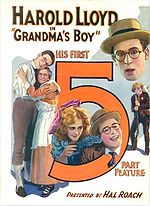Silent shorts and features[edit]
By 1918, Lloyd and Roach had begun to develop his character beyond an imitation of his contemporaries. Harold Lloyd would move away from tragicomic personas, and portray an everyman with unwavering confidence and optimism. The persona Lloyd referred to as his "Glass" character[11] (often named "Harold" in the silent films) was a much more mature comedy character with greater potential for sympathy and emotional depth, and was easy for audiences of the time to identify with. The "Glass" character is said to have been created after Roach suggested that Harold was too handsome to do comedy without some sort of disguise. To create his new character Lloyd donned a pair of lensless horn-rimmed eyeglasses but wore normal clothing;[4] previously, he had worn a fake mustache and ill-fitting clothes as the Chaplinesque "Lonesome Luke". "When I adopted the glasses," he recalled in a 1962 interview with Harry Reasoner, "it more or less put me in a different category because I became a human being. He was a kid that you would meet next door, across the street, but at the same time I could still do all the crazy things that we did before, but you believed them. They were natural and the romance could be believable." Unlike most silent comedy personae, "Harold" was never typecast to a social class, but he was always striving for success and recognition. Within the first few years of the character's debut, he had portrayed social ranks ranging from a starving vagrant in From Hand to Mouth to a wealthy socialite in Captain Kidd's Kids.
Lloyd's career was not all laughs, however. In August 1919, while posing for some promotional still photographs in the Los Angeles Witzel Photography Studio, he was seriously injured holding a prop bomb thought merely to be a smoke pot. It exploded and mangled his hand, causing him to lose a thumb and forefinger. The blast was severe enough that the cameraman and prop director nearby were also seriously injured. Lloyd was in the act of lighting a cigarette from the fuse of the bomb when it exploded, also badly burning his face and chest and injuring his eye. Despite the proximity of the blast to his face, he retained his sight. As he recalled in 1930, "I thought I would surely be so disabled that I would never be able to work again. I didn't suppose that I would have one five-hundredth of what I have now. Still I thought, 'Life is worth while. Just to be alive.' I still think so."[12]
Beginning in 1921, Roach and Lloyd moved from shorts to feature-length comedies. These included the acclaimed Grandma's Boy, which (along with Chaplin's The Kid) pioneered the combination of complex character development and film comedy, the highly popular Safety Last! (1923), which cemented Lloyd's stardom (and is the oldest film on the American Film Institute's List of 100 Most Thrilling Movies), and Why Worry? (1923).
Lloyd and Roach parted ways in 1924, and Lloyd became the independent producer of his own films. These included his most accomplished mature features Girl Shy, The Freshman (his highest-grossing silent feature), The Kid Brother, and Speedy, his final silent film. Welcome Danger (1929) was originally a silent film but Lloyd decided late in the production to remake it with dialogue. All of these films were enormously successful and profitable, and Lloyd would eventually become the highest paid film performer of the 1920s.[13] They were also highly influential and still find many fans among modern audiences, a testament to the originality and film-making skill of Lloyd and his collaborators. From this success he became one of the wealthiest and most influential figures in early Hollywood.

No comments:
Post a Comment